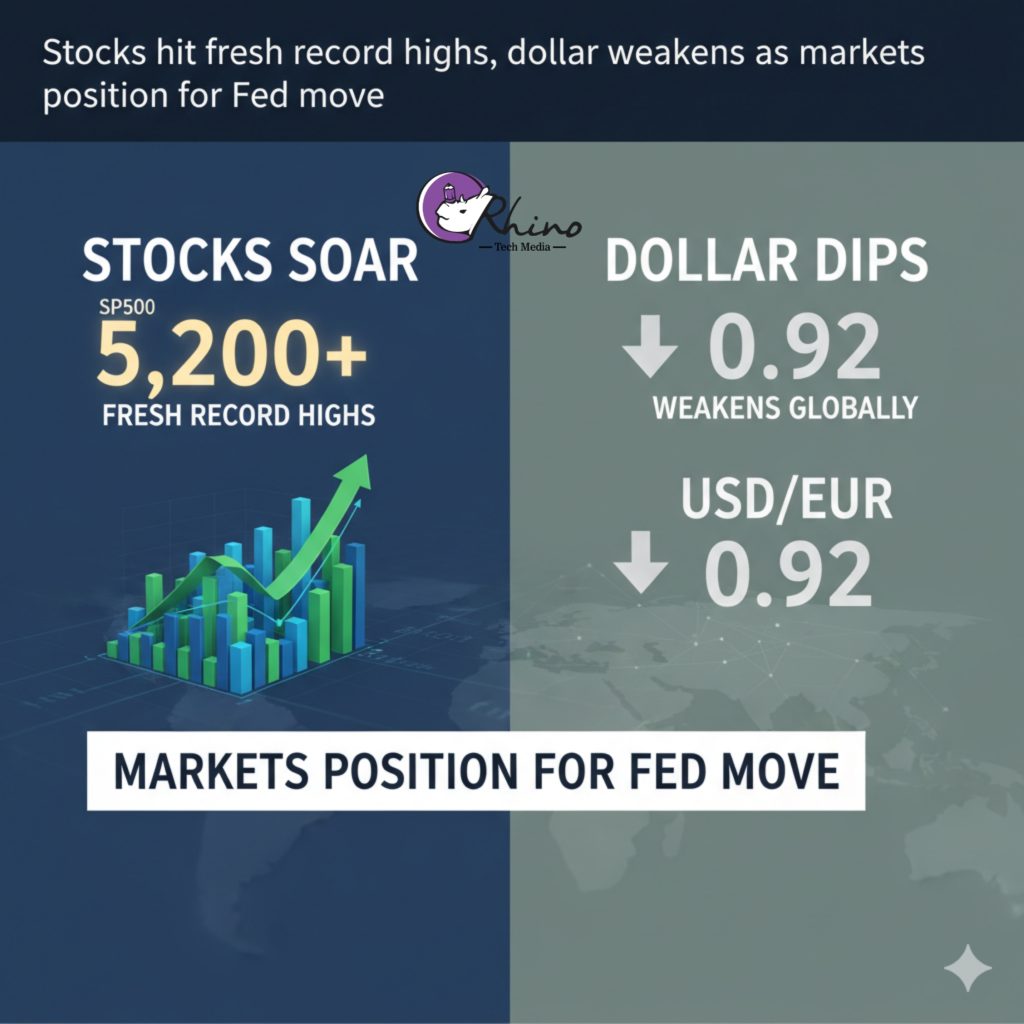Introduction
Global financial markets have recently witnessed a resurgence in optimism, with equity indices notching fresh all-time highs and the US dollar weakening against most major currencies. These moves reflect investor expectations that the US Federal Reserve is poised to begin easing monetary policy, likely by cutting interest rates. As markets await key signals from upcoming policy decisions and economic data, the shifts in risk perception, asset valuations, and capital flows are significant.
Market Rally and Equity Records
On September 15, 2025, global equity indices climbed to new peaks. Notably, U.S. benchmarks such as the S&P 500 and Nasdaq hit intraday record highs, while the MSCI All-Country World Index surpassed its previous record, gaining about 0.47%.
The enthusiasm is broad-based: Asia-Pacific shares rose, and European stocks also posted gains that day. However, the Dow Jones Industrial Average was relatively flat.
Underlying this advance is a widespread belief that the Fed will cut interest rates imminently (specifically a 25 basis point cut expected at its meeting on Wednesday of that week), with the probability of that move seen as nearly 100% by futures markets.
Dollar Weakness and Other Asset Moves
As equity markets rose, the U.S. dollar fell against several major currencies. For example, it dropped approximately 0.23% versus the Japanese yen and about 0.27% against the Swiss franc. The euro gained roughly 0.27% versus the dollar.
At the same time, yields on benchmark U.S. Treasuries, especially the 10-year note, declined modestly (10-year yield down a couple of basis points) as expectations for easing increased.
Gold prices also climbed, nearing record highs, supported by the softer dollar and the drop in yields. As non-yielding assets become more attractive in a lower interest rate environment, gold stands to benefit.
What’s Driving the Expectations for Fed Policy Easing
Several factors are converging to fuel market confidence in an upcoming Fed rate cut:
- Economic Data: Signs of easing in the labor market and contained inflation support the argument that monetary conditions are sufficiently restrictive or close to restrictive enough. Markets are interpreting recent data as tilting toward the downside risk for growth.
- Inflation: While inflation remains above the Fed’s long-term target, recent developments—especially in goods and wholesale prices—have moderated, underscoring possibilities for rate cuts.
- Market Pricing & Futures: Futures markets, including tools like CME’s FedWatch, are overwhelmingly pricing in a 25 bps cut, and even a few possible cuts by year-end.
- Fed Communications: Investors are looking closely to the Fed’s “dot plot” projections (which outline individual FOMC members’ estimates for future rate paths) and the tone Chair Jerome Powell sets in the post-meeting communications to gauge how dovish or cautious the Fed might be.
Risks & Caveats
While optimism is high, there are several risks and areas of uncertainty that could challenge prevailing expectations:
- “Sell on the news” risk: Because much of the rate cut is already priced in, there is risk of a market pullback if the outcome (e.g. how dovish the Fed actually is) disappoints. Investors may react negatively even to a cut if the forward guidance or projections are conservative.
- Inflation persistence: If inflation, especially in services or shelter, remains sticky, the Fed may be less willing to cut, or may proceed more slowly. This could dampen growth expectations or push yields back up.
- Labor market strength: If job gains remain strong or unemployment dips, the Fed may feel constrained from easing too aggressively.
- Global/geopolitical risks: External shocks—such as energy or commodity price spikes, supply chain disruptions, or geopolitical tensions—could also affect markets and force a more cautious Fed stance.
Implications for Investors
The unfolding situation has several implications:
- Equity exposure: Investors may favor sectors that benefit from lower interest rates (e.g. growth/tech) or are sensitive to financing costs.
- Currency positioning: With the dollar weakening, non-USD assets may become more attractive; exporters and multinational companies could see shifts in profitability.
- Fixed income and yields: Lower yields could make bonds less rewarding, but falling Treasury yields help reduce discount rates, bolstering equity valuations.
- Gold & commodities: Precious metals are benefiting, and in a lower-yield, lower real rate environment, they may continue to do well.
Outlook
Given the strong market positioning, it seems likely that the Fed will deliver a modest cut (25 bps), but attention will shift strongly to what happens afterwards—how many additional cuts, how quickly, and how rate-paths are projected. The dot plot and the Fed Chair’s press conference will be critical.
In conclusion, the current market behavior—record equity highs, a weakened dollar, lower yields—is suggestive of an inflection point in policy expectations. Investors appear to be leaning toward a shift from tightening to easing, but much will depend on incoming data and the Fed’s messaging.

